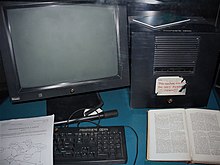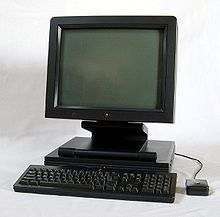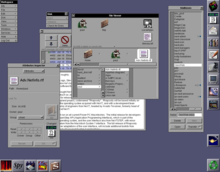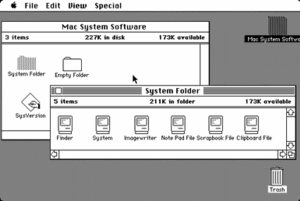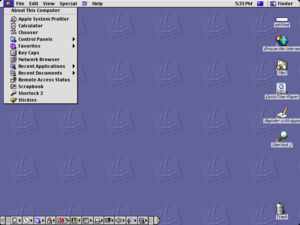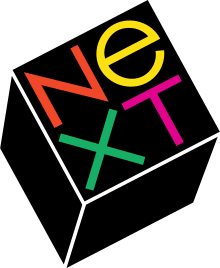
NeXT's logo, designed by Paul Rand
| |
| Private | |
| Industry | |
| Fate | Merged into Apple |
| Founded | June 20, 1985 |
| Founder | Steve Jobs |
| Defunct | February 7, 1997 |
| Headquarters |
,
U.S.
|
Key people
|
|
| Products | |
Number of employees
| 540 (1992) |
| Website | next.com (archived) |
NeXT, Inc. (later NeXT Computer, Inc. and NeXT Software, Inc.) was an American computer and software company founded in 1985 by Apple Computer co-founder Steve Jobs. Its name was usually pronounced as "Next". Based in Redwood City, California, the company developed and manufactured a series of computer workstations intended for the higher education and business markets. NeXT was founded by Jobs after he was fired from Apple, along with several co-workers. NeXT introduced the first NeXT Computer in 1988, and the smaller NeXTstation in 1990. The NeXT computers experienced relatively limited sales, with estimates of about 50,000 units shipped in total. Nevertheless, their innovative object-oriented NeXTSTEP operating system and development environment (Interface Builder) were highly influential.
The first major outside investment was from Ross Perot, who invested after seeing a segment about NeXT on The Entrepreneurs. In 1987, he invested $20 million in exchange for 16 percent of NeXT's stock and subsequently joined the board of directors in 1988.
NeXT later released much of the NeXTSTEP system as a programming environment standard called OpenStep. NeXT withdrew from the hardware business in 1993 to concentrate on marketing OPENSTEP for Mach, its own OpenStep implementation, for several original equipment manufacturers (OEMs). NeXT also developed WebObjects, one of the first enterprise web application frameworks. WebObjects never became very popular because of its initial high price of $50,000, but it remains a prominent early example of a Web server based on dynamic page generation rather than on static content.
Apple purchased NeXT in 1997 for $429 million (equivalent to $670 million in 2018), and 1.5 million shares of Apple stock. As part of the agreement, Steve Jobs, Chairman and CEO of NeXT Software, returned to Apple, the company he co-founded in 1976. The founder promised to merge software from NeXT with Apple's hardware platforms, eventually resulting in macOS, iOS, watchOS, and tvOS. These operating systems are completely based upon the NeXTSTEP and OPENSTEP foundation.
History
Background
In 1985, Apple co-founder Steve Jobs led Apple's SuperMicro division, which was responsible for the development of the Macintosh and Lisa personal computers. The Macintosh had been successful on university campuses partly because of the Apple University Consortium, which allowed students and institutions to buy the computers at a discount. The consortium had earned more than $50 million on computers by February 1984.
While chairman, Jobs visited university departments and faculty members to sell Macintosh. Jobs met Paul Berg, a Nobel Laureate in chemistry, at a luncheon held in Silicon Valley to honor François Mitterrand, then President of France. Berg was frustrated by the expense of teaching students about recombinant DNA from textbooks instead of in wet laboratories,
used for the testing and analysis of chemicals, drugs, and other
materials or biological matter. Wet labs were prohibitively expensive
for lower-level courses and were too complex to be simulated on personal
computers of the time. Berg suggested to Jobs to use his influence at
Apple to create a "3M computer" workstation for higher education, featuring at least one megabyte of random-access memory (RAM), a megapixel display and megaFLOPs performance, hence the name "3M".
Jobs was intrigued by Berg's concept of a workstation and
contemplated starting a higher education computer company in the fall of
1985, amidst increasing turmoil at Apple. Jobs' division did not
release upgraded versions of the Macintosh and much of the Macintosh Office system. As a result, sales plummeted, and Apple was forced to write off millions of dollars in unsold inventory. Apple's chief executive officer (CEO) John Sculley ousted Jobs from his day-to-day role at Apple, replacing him with Jean-Louis Gassée in 1985. Later that year, Jobs began a power struggle to regain control of the company. The board of directors sided with Sculley while Jobs took a business visit to Western Europe and the Soviet Union on behalf of Apple.
Original NeXT team
After
several months of being sidelined, Jobs resigned from Apple on
September 13, 1985. He told the board he was leaving to set up a new
computer company, and that he would be taking several Apple employees
from the SuperMicro division with him. He also told the board that his
new company would not compete with Apple and might even consider
licensing its designs back to them to market under the Macintosh brand.
Jobs named his new company Next, Inc. A number of former Apple employees followed him to Next, including Joanna Hoffman, Bud Tribble, George Crow, Rich Page, Susan Barnes, Susan Kare,
and Dan'l Lewin. After consulting with major educational buyers from
around the country, including a follow-up meeting with Paul Berg, a
tentative specification for the workstation was drawn up. It was
designed to be powerful enough to run wet lab simulations and cheap
enough for college students to use in their dormitory rooms. Before the specifications were finished, however, Apple sued Next for "nefarious schemes" to take advantage of the cofounders' insider information.
Jobs remarked, "It is hard to think that a $2 billion company with
4,300-plus people couldn't compete with six people in blue jeans." The suit was eventually dismissed before trial.
In 1986, Jobs recruited the famous graphic designer Paul Rand to create a brand identity costing $100,000.
Jobs recalled, "I asked him if he would come up with a few options, and
he said, 'No, I will solve your problem for you and you will pay me.
You don’t have to use the solution. If you want options go talk to other
people.'"
Rand created a 20-page brochure detailing the brand, including the
precise angle used for the logo (28°) and a new company name spelling,
NeXT.
1987–93: NeXT Computer
First generation
This original NeXT Computer was used by Tim Berners-Lee at CERN, and became the world's first Web server and ran the world's first Web browser in 1990
I want some kid at Stanford to be able to cure cancer in his dorm room. Steve Jobs, on the purpose of the new NeXT cube
NeXT changed its business plan in mid-1986. The company decided to
develop both computer hardware and software, instead of just a low-end
workstation. A team led by Avie Tevanian, who had joined the company after working as one of the Mach kernel engineers at Carnegie Mellon University, was to develop the NeXTSTEP operating system. The hardware division, led by Rich Page — one of the cofounders who had previously led the Apple Lisa team — designed and developed the hardware. NeXT's first factory was completed in Fremont, California in 1987. It was capable of producing 150,000 machines per year. NeXT's first workstation was officially named the NeXT Computer, although it was widely termed "the cube" because of its distinctive case, a 1 ft magnesium cube, designed by Apple IIc case designer Frogdesign in accordance with an edict from Jobs.
The original design team had anticipated releasing the computer for US$3,000 in spring of 1987 to be ready for sale by summer of that year. The NeXT Computer received standing ovations when revealed at a lavish, invitation-only gala event, "NeXT Introduction — the Introduction to the NeXT Generation of Computers for Education" at the Louise M. Davies Symphony Hall, San Francisco,
California on Wednesday October 12, 1988. The following day, selected
educators and software developers were invited (for $100 registration
fee) to attend the first public technical overview of the NeXT computer
at an event called "The NeXT Day" held at the San Francisco Hilton. This
event gave developers interested in developing NeXT software an insight
into the software architecture, object-oriented programming and developing for the NeXT Computer. The luncheon speaker was Steve Jobs.
The first machines were tested in 1989, after which NeXT started selling limited numbers to universities with a beta version of the NeXTSTEP operating system installed. Initially the NeXT Computer was targeted at U.S. higher education establishments only, with a base price of $6,500.
The machine was widely reviewed in magazines, generally concentrating on
the hardware. When asked if he was upset that the computer's debut was
delayed by several months, Jobs responded, "Late? This computer is five
years ahead of its time!"
The NeXT Computer was based on the new 25 MHz Motorola 68030 central processing unit (CPU). The Motorola 88000 RISC chip was originally considered, but was not available in sufficient quantities. It included between 8 and 64 MB of random-access memory (RAM), a 256 MB magneto-optical (MO) drive, a 40 MB (swap-only), 330 MB, or 660 MB hard disk drive, 10BASE2 Ethernet, NuBus and a 17-inch MegaPixel grayscale display measuring 1120 by 832 pixels. In 1989 a typical new PC, Macintosh, or Amiga
computer included a few megabytes of RAM, a 640×480 16-color or 320x240
4000-color display, a 10 to 20 megabyte hard drive and few networking capabilities.
It also was the first computer to ship with a general-purpose DSP chip
(Motorola 56001) on the motherboard. This was used to support
sophisticated music and sound processing, including the Music Kit software.
The magneto-optical drive manufactured by Canon Inc. was used as the primary mass storage device. These drives were relatively new to the market, and the NeXT was the first computer to use them.
They were cheaper than hard drives (blank media especially so: though
each had a cost of $150 to Canon, Jobs's typically forthright
negotiations saw Canon agree to a retail of only $50 apiece) but slower
(with an average seek time
of 96 ms). The design made it impossible to move files between
computers without a network, since each NeXT Computer had only one MO
drive and the disk could not be removed without shutting down the
system.
Storage options proved challenging for the first NeXT Computers. The
magneto-optical media was relatively expensive and had performance and
reliability problems despite being faster than a floppy drive.
The drive was not sufficient to run as the primary medium running the
NeXTSTEP operating system both in terms of speed or capacity.
In 1989, NeXT struck a deal for former Compaq
reseller Businessland to sell NeXT computers in select markets
nationwide. Selling through a retailer was a major change from NeXT's
original business model of only selling directly to students and
educational institutions.
Businessland founder David Norman predicted that sales of the NeXT
Computer would surpass sales of Compaq computers after 12 months.
In 1989, Canon invested US$100 million in NeXT, giving it a 16.67 percent stake,
making NeXT worth almost $600 million. Canon invested in NeXT with the
condition that it would be able to use the NeXTSTEP environment with its
own workstations, which would mean a greatly expanded market for the
software. After NeXT exited the hardware business, Canon produced a line
of PCs, called object.station, including models 31, 41, 50 and 52, specifically designed to run NeXTSTEP/Intel. Canon also served as NeXT's distributor in Japan.
NeXT computers were first released on the retail market in 1990,
for $9,999. NeXT's original investor Ross Perot resigned from the board
of directors in June 1991 to dedicate more time to Perot Systems, a Plano, Texas-based systems integrator.
Second generation
A NeXTstation with the original keyboard, mouse and the NeXT MegaPixel monitor
NeXT released a second generation of workstations in 1990. The new range included a revised NeXT Computer, renamed the NeXTcube, and the NeXTstation, nicknamed "the slab," which used a "pizza box"
case form-factor. Jobs was explicit in ensuring NeXT staff did not use
the latter terminology, lest the NeXT machines be compared to competing
Sun workstations. The magneto-optical drive was replaced with a 2.88 MB
floppy drive to offer users a way to use their floppy disks. However,
individual 2.88 MB floppies were expensive and the technology did not
supplant the 1.44 MB floppy. Realizing this, NeXT utilized the CD-ROM
drive, which eventually became an industry standard for storage. Color
graphics were available on the NeXTstation Color and the NeXTdimension graphics processor hardware for the NeXTcube. The new computers were cheaper and faster than their predecessors, with the new Motorola 68040 processor.
In 1992, NeXT launched "Turbo" variants of the NeXTcube and
NeXTstation with a 33 MHz 68040 processor and maximum RAM capacity
increased to 128 MB. NeXT sold 20,000 computers in 1992 (NeXT counted
upgraded motherboards on back order as sales) — a small number compared
with their competitors. However, the company reported sales of
$140 million for the year, encouraging Canon to invest a further
$30 million to keep the company afloat.
In its existence, Next has sold a total of 50,000 copies of Nextstep, says Jobs. It's not much of an installed base, so he predicts the company will ship 50,000 Nextstep packages in 1993. But Next needs to increase its volume three-fold in order to build enough momentum to forestall Microsoft and Taligent in the object-oriented software business. UnixWorld, April 1993
In total, 50,000 NeXT machines were sold, including thousands to the then super secret National Reconnaissance Office
located in Chantilly, Virginia. NeXT's long-term aim was to migrate to
the RISC (Reduced Instruction Set Computing) architecture, a processor
design strategy intended to increase performance. The project was known
as the NeXT RISC Workstation (NRW). Initially the NRW was to be based on the Motorola 88110
processor, but due to a lack of confidence in Motorola's commitment to
the 88000-series architecture, it was later redesigned around dual PowerPC 601s. NeXT produced some motherboards and enclosures, but exited the hardware business before full production.
Software applications
NeXT computers were delivered with Mathematica pre-installed. Several developers used the NeXT platform to write pioneering programs. Tim Berners-Lee used a NeXT Computer in 1990 to create the first Web browser and Web server; accordingly, NeXT was instrumental in the development of the World Wide Web.
NeXT was an engineering computer used by professors for the most
serious science challenges, and also for developing finished newspaper
layouts using News running on Next. George Mason University
in the early 1990s had a set of them for publishing, as well as Silicon
Graphics for CAD/GL and Mathematica for astrophysics. The games Doom, Doom II: Hell on Earth and Quake were developed by id Software on NeXT machines. Other games based on the Doom engine, such as Heretic and Hexen: Beyond Heretic by Raven Software, as well as Strife by Rogue Entertainment were also developed on NeXT hardware using id's tools.
Other commercial programs were released for NeXT computers,
including Altsys Virtuoso, a vector drawing program with page-layout
features which was ported to Mac OS and Microsoft Windows as Aldus
FreeHand v4, and the Lotus Improv spreadsheet program. The systems also came with a number of smaller built-in applications, such as the Merriam-Webster Collegiate Dictionary, Oxford Quotations, the complete works of William Shakespeare, and the Digital Librarian search engine to access them.
1993–96: NeXT Software
NeXTSTEP, the operating system used by the NeXTcube and NeXTstation
NeXT started porting the NeXTSTEP operating system to IBM PC compatible computers using the Intel 80486
processor in late 1991. The operating system was ported to Intel's
architecture because of a change in NeXT's business strategy, which was
then to remove themselves from the hardware business entirely. A
demonstration of the port was displayed at the NeXTWorld Expo in January
1992. By mid-1993 the product was complete and version 3.1, also known
as NeXTSTEP 486, was released. Prior to the release of NeXTSTEP, Chrysler planned to buy 3,000 copies in 1992.
NeXTSTEP 3.x was later ported to PA-RISC and SPARC-based
platforms, for a total of four versions: NeXTSTEP/NeXT (for NeXT's 68k
"black boxes"), NeXTSTEP/Intel, NeXTSTEP/PA-RISC and NeXTSTEP/SPARC.
Although these ports were not widely used, NeXTSTEP gained popularity at
institutions such as First Chicago NBD, Swiss Bank Corporation, O'Connor and Company, and other organizations owing to its programming model. It was also used by many American federal agencies, such as United States Naval Research Laboratory, the National Security Agency, the Advanced Research Projects Agency, the Central Intelligence Agency and the National Reconnaissance Office.
Some IBM PC clone vendors offered somewhat customized hardware
solutions that were delivered running NeXTSTEP on Intel, such as the
Elonex NextStation and the Canon object.station 41.
NeXT withdrew from the hardware business in 1993 and the company was renamed NeXT Software Inc; consequently, 300 of the 540 staff employees were laid off. NeXT negotiated to sell the hardware business, including the Fremont factory, to Canon. Canon later pulled out of the deal. Work on the PowerPC machines was stopped, along with all hardware production. CEO of Sun Microsystems Scott McNealy announced plans to invest $10 million in 1993 and use NeXT software (OpenStep) in future Sun systems. NeXT partnered with Sun to create OpenStep which was NeXTSTEP without the Mach-based kernel.
After dropping the hardware business, NeXT returned to selling a
toolkit to run on other operating systems, in effect returning to the
original business plan. New products based on OpenStep were released,
including OpenStep Enterprise, a version for Microsoft's Windows NT. The company also launched WebObjects, a platform for building large-scale dynamic web applications. Many large businesses including Dell, Disney, WorldCom, and the BBC used this WebObjects software for a short time. Eventually WebObjects was used solely to power Apple's iTunes Store and most of its corporate Web site, though it is no longer in use.
1996–97: purchase by Apple
We went for one of our, you know, signature Steve Jobs walks around Palo Alto, and ... we happened to see someone who was in that meeting from the [Apple] management team who said, 'You guys won easily, no problem. You have nothing to worry about.' Avie Tevanian, presenting NeXT versus Be to Apple
Apple Computer announced an intention to acquire NeXT on December 20, 1996. Apple paid $429 million in cash, which went to the initial investors and 1.5 million Apple shares, which went to Steve Jobs, who was deliberately not given cash for his part in the deal. The main purpose of the acquisition was to use NeXTSTEP as a foundation to replace the dated classic Mac OS, instead of BeOS or the in-development Copland. The deal was finalized on February 7, 1997, bringing Jobs back to Apple as a consultant, who was later appointed as interim CEO.
In 2000, Jobs took the CEO position as a permanent assignment, holding
the position until his resignation on August 24, 2011; Jobs died six
weeks later on October 5, 2011 from complications of a relapsed pancreatic neuroendocrine tumor.
Several NeXT executives replaced their Apple counterparts when
Steve Jobs restructured the company's board of directors. Over the next
five years the NeXTSTEP operating system was ported to the PowerPC
architecture. At the same time, an Intel port and OpenStep Enterprise
toolkit for Windows were both produced. The operating system was code
named Rhapsody,
while the toolkit for development on all platforms was called "Yellow
Box". For backwards compatibility Apple added the "Blue Box" to
Rhapsody, allowing existing Mac applications to be run in a
self-contained cooperative multitasking environment.
A server version of the new operating system was released as Mac OS X Server 1.0 in 1999, and the first consumer version, Mac OS X 10.0, in 2001. The OpenStep developer toolkit was renamed Cocoa. Rhapsody's Blue Box was renamed Classic Environment
and changed to run applications full-screen without requiring a
separate window. Apple included an updated version of the original
Macintosh toolbox, called Carbon, that gave existing Mac applications access to the environment without the constraints of Blue Box. Some of NeXTSTEP's interface features were used in Mac OS X, including the Dock, the Services menu, the Finder's "Column" view, and the Cocoa text system.
NeXTSTEP's processor-independent capabilities were retained in
Mac OS X, leading to both PowerPC and Intel x86 versions (although only
PowerPC versions were publicly available before 2006). Apple moved to
Intel processors by August 2006.
Corporate culture and community
Jobs
created a different corporate culture at NeXT in terms of facilities,
salaries, and benefits. Jobs had experimented with some structural
changes at Apple but at NeXT he abandoned conventional corporate
structures, instead making a "community" with "members" instead of
employees. There were only two different salaries at NeXT until the early 1990s.
Team members who joined before 1986 were paid $75,000 while those who
joined afterwards were paid $50,000. This caused a few awkward
situations where managers were paid less than their employees. Employees
were given performance reviews and raises every six months because of
the spartan salary plans. To foster openness, all employees had full
access to the payrolls, although few employees ever took advantage of
the privilege. NeXT's health insurance
plan offered benefits to not only married couples but unmarried couples
and same-sex couples, although the latter privilege was later withdrawn
due to insurance complications.
The payroll schedule was also very different from other companies in
Silicon Valley at the time: instead of getting paid twice a month in
arrears (that is, at the end of the pay period), employees would get
paid once a month in advance (at its beginning, in other words).
Jobs found office space in Palo Alto, California on 3475 Deer Creek Road, occupying a glass and concrete building which featured a staircase designed by architect I. M. Pei.
The first floor used hardwood flooring and large worktables where the
workstations would be assembled. To avoid inventory errors, NeXT used
the just-in-time (JIT) inventory strategy. The company contracted out for all major components
such as mainboards and cases and had the finished components shipped to
the first floor for assembly. The second floor was the office space
with an open floor plan. The only enclosed rooms were Jobs's office and a
few conference rooms.
As NeXT expanded, more office space was needed. The company rented an office at 800 and 900 Chesapeake Drive in Redwood City,
also designed by Pei. The architectural centerpiece was a "floating"
staircase with no visible supports. The open floor plan was retained,
although furnishings became luxurious, with $5,000 chairs, $10,000 sofas
and Ansel Adams prints.
NeXT's first former campus in Palo Alto was subsequently occupied by SAP AG. Its second former campus in Redwood City was occupied by ApniCure and OncoMed Pharmaceuticals Inc.
The first issue of NeXTWORLD magazine was printed in 1991. It was published in San Francisco
by Integrated Media and edited by Michael Miley and later Dan Ruby. It
was the only mainstream periodical to discuss NeXT computers, the
operating system, and NeXT software. The publication was discontinued in
1994 after only four volumes. A NeXTWORLD Expo followed as a developer conference, held in 1991 and 1992 at the San Francisco Civic Center and in 1993 and 1994 at the Moscone Center in San Francisco, with Steve Jobs as the keynote speaker.
Influence on the computer industry
Though not very profitable, the company had a wide-ranging impact on the computer industry. Object-oriented programming and graphical user interfaces
became more common after the 1988 release of the NeXTcube and NeXTSTEP.
The technologically successful platform was often held as the
trendsetter when other companies started to emulate the success of
NeXT's object-oriented system.
Microsoft announced the Cairo project
in 1991; the Cairo specification included similar object-oriented user
interface features for a coming consumer version of Windows NT. Although
the project was ultimately abandoned, some elements were integrated
into other projects. By 1994, Microsoft and NeXT were collaborating on a
Windows NT port of OpenStep; the port, however, was never released.
By 1993, Taligent
was considered by the press to be a competitor in objects and operating
systems even without any product release, with NeXT being a main point
of comparison. For the first few years, Taligent's theoretical newness
was often compared to NeXT's older but mature and commercially
established platform, but Taligent's debut release in 1995 was called "too little, too late" especially compared to NeXT.
WebObjects failed to achieve wide popularity partly because of the initial high price of US$50,000,
but it remains the first and most prominent early example of a web
application server that enabled dynamic page generation based on user
interactions as opposed to static content. WebObjects is now bundled
with macOS Server and Xcode.
